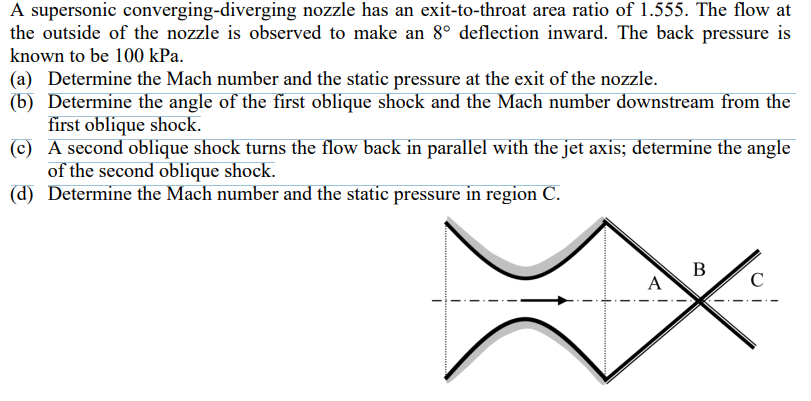A supersonic converging-diverging nozzle has an exit-to-throat area ratio of 1.555. The flow at the outside of the nozzle is observed to make an 8° deflection inward. The back pressure is known to be 100 kPa. (a) Determine the Mach number and the static pressure at the exit of the nozzle. (b) Determine the angle of the first oblique shock and the Mach number downstream from the first oblique shock. (c) A second oblique shock turns the flow back in parallel with the jet axis; determine the angle of the second oblique shock. (d) Determine the Mach number and the static pressure in region C. A B C
A supersonic converging-diverging nozzle has an exit-to-throat area ratio of 1.555. The flow at the outside of the nozzle is observed to make an 8° deflection inward. The back pressure is known to be 100 kPa. (a) Determine the Mach number and the static pressure at the exit of the nozzle. (b) Determine the angle of the first oblique shock and the Mach number downstream from the first oblique shock. (c) A second oblique shock turns the flow back in parallel with the jet axis; determine the angle of the second oblique shock. (d) Determine the Mach number and the static pressure in region C. A B C
Elements Of Electromagnetics
7th Edition
ISBN:9780190698614
Author:Sadiku, Matthew N. O.
Publisher:Sadiku, Matthew N. O.
ChapterMA: Math Assessment
Section: Chapter Questions
Problem 1.1MA
Related questions
Question
I3

Transcribed Image Text:A supersonic converging-diverging nozzle has an exit-to-throat area ratio of 1.555. The flow at
the outside of the nozzle is observed to make an 8° deflection inward. The back pressure is
known to be 100 kPa.
(a) Determine the Mach number and the static pressure at the exit of the nozzle.
(b) Determine the angle of the first oblique shock and the Mach number downstream from the
first oblique shock.
(c)
A second oblique shock turns the flow back in parallel with the jet axis; determine the angle
of the second oblique shock.
(d) Determine the Mach number and the static pressure in region C.
A
B
C
Expert Solution
This question has been solved!
Explore an expertly crafted, step-by-step solution for a thorough understanding of key concepts.
This is a popular solution!
Trending now
This is a popular solution!
Step by step
Solved in 2 steps with 2 images

Knowledge Booster
Learn more about
Need a deep-dive on the concept behind this application? Look no further. Learn more about this topic, mechanical-engineering and related others by exploring similar questions and additional content below.Recommended textbooks for you

Elements Of Electromagnetics
Mechanical Engineering
ISBN:
9780190698614
Author:
Sadiku, Matthew N. O.
Publisher:
Oxford University Press

Mechanics of Materials (10th Edition)
Mechanical Engineering
ISBN:
9780134319650
Author:
Russell C. Hibbeler
Publisher:
PEARSON

Thermodynamics: An Engineering Approach
Mechanical Engineering
ISBN:
9781259822674
Author:
Yunus A. Cengel Dr., Michael A. Boles
Publisher:
McGraw-Hill Education

Elements Of Electromagnetics
Mechanical Engineering
ISBN:
9780190698614
Author:
Sadiku, Matthew N. O.
Publisher:
Oxford University Press

Mechanics of Materials (10th Edition)
Mechanical Engineering
ISBN:
9780134319650
Author:
Russell C. Hibbeler
Publisher:
PEARSON

Thermodynamics: An Engineering Approach
Mechanical Engineering
ISBN:
9781259822674
Author:
Yunus A. Cengel Dr., Michael A. Boles
Publisher:
McGraw-Hill Education

Control Systems Engineering
Mechanical Engineering
ISBN:
9781118170519
Author:
Norman S. Nise
Publisher:
WILEY

Mechanics of Materials (MindTap Course List)
Mechanical Engineering
ISBN:
9781337093347
Author:
Barry J. Goodno, James M. Gere
Publisher:
Cengage Learning

Engineering Mechanics: Statics
Mechanical Engineering
ISBN:
9781118807330
Author:
James L. Meriam, L. G. Kraige, J. N. Bolton
Publisher:
WILEY